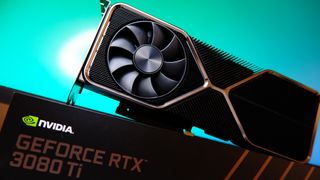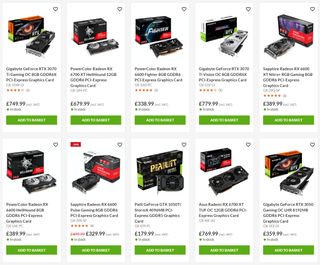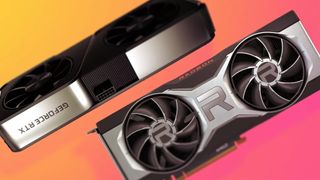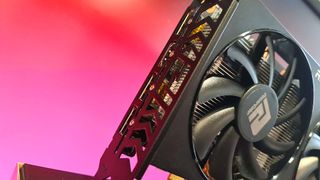GPU stock levels are now so good today's brutal pricing cannot last
If supply continues to improve, power will be back in the hands of PC builders after a year and a half of scrambling for stock.

For the past year and a half I've been scouring the web for any glimmer of hope that graphics card pricing may be coming back down to Earth—an ongoing GPU shortage has left us scrabbling for stock, resulting in high prices and high costs for entry into the wonderful world of PC gaming. Largely to no avail, of course.
Today, however, I can be far more positive about my findings.
Look to major retailers in the UK, EU, and the US and you'll find something strange when you search their virtual shelves for the rare graphics card. Not only are there GPUs in stock, but there is a wide availability of many models and versions to suit multiple budgets. Scroll through Best Buy, Overclockers, or MindFactory and you'll be pleasantly greeted by listing after listing touting "in stock", "available to buy", or "add to basket".
However, only a few, if any, are for graphics cards at or close to MSRP.
The only GPU that's regularly spotted near or at MSRP is AMD's RX 6500 XT, one of the more recent arrivals to the RX 6000-series lineup. It's not a card we're altogether fond of, in all honesty, but it is a modern GPU that resembles anything close to affordable.
Beyond that, website 3DCenter has been keeping an eye on graphics card pricing over the past year, and its latest report from Germany shows both AMD and Nvidia graphics cards with price tags averaging around 25% over MSRP. That's the lowest premium on graphics cards noted in the site's report for over a year, and no doubt improving supply has put an end to the frenzied demand that saw graphics cards going for double, or triple, their original value.
But how long can any inflation of graphics card prices last if stock continues to improve?
The biggest gaming news, reviews and hardware deals
Keep up to date with the most important stories and the best deals, as picked by the PC Gamer team.
I'd guess not long, though it's not going to be as simple as returning to 'business as usual' and offering cards at MSRP at a moment's notice. Business as usual for two years hasn't been anything close to MSRP, and that has all sorts of implications all the way up the supply chain.

With hundreds of graphics cards listed as in stock across multiple major retailers in Western Europe and North America, there is undoubtedly a competitive advantage to the retailers that can drop prices further than others. Though this is a double-edged sword for most: manufacturers have faced increased prices for key components, and that has been passed onward down the retail chain. Most often, it's the customers who end up footing the bill, but if demand eases off so totally, and supply improves, it may have to be retailers that take the brunt of lowering price tags.
Those increased component costs are reportedly easing now and in the coming months. We've also heard directly that GPU manufacturer Asus is "aggressively" dropping prices across many of its GPUs.
Though for the extant stock at retailers today these costs are less likely to have an immediate impact. After all these SKUs were likely to have been purchased at a higher cost to the retailer months ago. Lead times for GPUs have been so lengthy these past few years, that we heard of retailers ordering far in advance to secure stock.
I am seeing some glimmers of hope, just as you are.
Dr. Thomas Goldsby
Though retailers may have little choice if all goes well for GPU supply. It's like price tag Jenga: if one retailer drops prices, the rest will likely follow.
Speaking with Dr. Thomas Goldsby, the Haslam Chair of Logistics at the University of Tennessee’s Master's of Science in Supply Chain Management online program, about this very topic, he told me that there is a drive for retailers to act in this way when it becomes clear that supply is catching up with demand.
"As for the graphics card situation, I would expect prices to come down when it becomes apparent that supply is catching up and that they are readily available," Goldsby says. "A supplier out there will get nervous that they are sitting on considerable supply for an item that has a limited shelf life (with newer cards entering the market) and will make the move to clear out that excess inventory. Peer suppliers will then have to follow that lead. And back to equilibrium we fall."

Last year, when things were really bleak, we first spoke to Dr. Thomas Goldsby about what was going on to cause the chip crisis and how it might end.
Graphics cards absolutely fall into the category of items with a limited shelf life. While they don't grow mouldy or turn into fetid fridge slime, AMD and Nvidia will always be pushing the performance envelope to deliver gains with every generation but also keep up appearances as companies on the bleeding edge of technology. That's exactly what both companies are doing, developing new Lovelace and RDNA 3 graphics cards for launch later this year.
Intel is also on the eve of releasing its first Intel Arc graphics cards on mobile platforms, which further mounts pressure on what's available today.
So these cards have to go, and if the demand isn't there at today's tall prices, something's got to give.
Major UK tech retailer Box has said it expects "things to return to a more attractive price" by the end of April/beginning of May, in a chat with Techradar.
What also feeds a competitive retail environment is the ability of customers to be discerning over where and what they purchase. You cannot be picky when supply is non-existent, but once there's a broad church of availability across model and retailer, customers are once again back in charge.
The key will be whether this recent influx of graphics cards will be maintained for a period of months. If that's possible—and signs do point to an improved supply through the second half of the year—then PC gamers may finally be able to have the freedom to choose what's best for them, at a fair price, and not have to rampantly hit refresh on a webpage for a chance to get the best value cards.
Now the graphics cards that are inherently not great value to begin with, such as the RTX 3080 12GB (not to be confused with the awesome 10GB version), may stay that way. But a few bad apples shouldn't ruin the barrel, and you never know what might get a desperate price cut eventually.

The reasons for the improving supply could be many, but speaking with Dr. Goldsby, he says the impact of people returning to "normal life" post-Covid-19 cannot be understated.
"By virtue of Omicron presenting this ugly head and fortunately starting to relent—it helps us on both sides," Goldsby says. "It helps us in terms of people getting back and starting to live a little bit more in a sense of a normal life. And then also our ability of our supply chains to perform at a kind of pre-Covid level. And so there is some normalising, which I think would help to explain why maybe supplies a bit improved, maybe prices are starting to, to relent a little bit.
"But I am seeing some glimmers of hope, just as you are," he continues.

Best CPU for gaming: The top chips from Intel and AMD
Best gaming motherboard: The right boards
Best graphics card: Your perfect pixel-pusher awaits
Best SSD for gaming: Get into the game ahead of the rest
It might be risky to utter these words, but I really am beginning to be a little hopeful for the graphics card market in 2022.
For that reason, there's a good case to be made for those considering a graphics card upgrade in 2022 to gamble on stock improving further and prices dropping relatively quickly. After all, you've waited this long, why not a little longer and try and pick up an RTX 30-series GPU at or under MSRP? Those cards are now closer to the end of their life than the start of them, and no one should be paying over-the-odds for them anymore.
It is still a gamble, but one I'm increasingly considering worth taking as 2022 marches on.

Jacob earned his first byline writing for his own tech blog. From there, he graduated to professionally breaking things as hardware writer at PCGamesN, and would go on to run the team as hardware editor. He joined PC Gamer's top staff as senior hardware editor before becoming managing editor of the hardware team, and you'll now find him reporting on the latest developments in the technology and gaming industries and testing the newest PC components.
Most Popular


